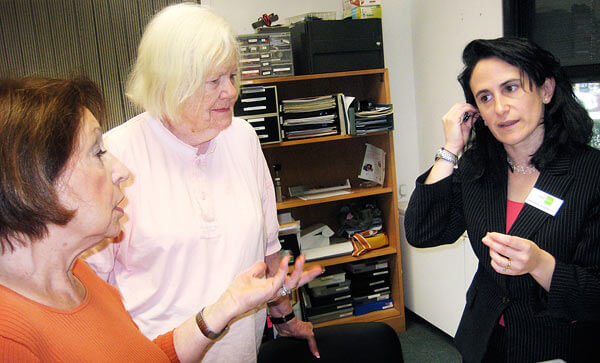By Rebecca Henely
In a presentation at East Elmhurst’s Lexington Hearing and Speech Center last week, audiologist Solange Anderson spoke about the recent advances in hearing aid technology, saying that even those who suffer from mild hearing loss can benefit from an aid.
“There’s ways to help you overcome some of those challenges,” Anderson said.
The presentation was one of two on new hearing aid technology held at the school and one of many events the institution, at 75th Street and 25th Avenue, holds for the hearing impaired of all ages throughout the year.
Anderson, who works for the hearing aid company Phonak and uses a hearing aid herself, said one in 10 Americans suffer from mild to profound hearing loss, with 30 percent of those with hearing loss older than 60.
“Hearing loss doesn’t have a particular mold,” she said. “It doesn’t have a particular face.”
She said those with sensorineural hearing loss, which is caused by problems with the nerve in the inner ear, can be treated through hearing aids. Aids can sometimes also help those suffering from tinnitus, or ringing in the ear.
Hearing loss can cause people frustration when they try to communicate and lead them to avoid social encounters. It can even result in physical maladies such as vertigo and dizziness, Anderson said.
She said many people put off addressing hearing loss for as long as 10 years and lose the sense of what certain noises should sound like, which can have traumatic results.
“If you put off addressing your hearing, you actually lose more and more of your ability to understand speech,” Anderson said.
Many do not get hearing aids because they are in denial over their hearing loss, fear a social stigma or are worried about the cost, Anderson said. Cost remains a problem, although Anderson recommends that those with less active lifestyles can make do with less expensive hearing aids.
But she said hearing aids now are so small, often many times smaller than the average hands-free headset, that any concern about a stigma should not be an issue.
“They’re so tiny now that they’re often less than the size of a dime,” Anderson said.
The technology that goes into hearing aids is also improving. Anderson said many hearing aids have features to let the listener focus on certain sounds and turn out ambient noises such as loud talking in a restaurant. Other aids have a microphone that can be turned via remote control so users can listen to someone sitting next to them in a car without turning their head.
She said these aids, as well as surgery, can be a benefit at any age, although she cautioned that no device or operation can give the user completely normal hearing.
“As long as you know it’s a tool to help you improve your life, that’s the way to go,” Anderson said.
The school offers intensive hearing tests for those who believe they may have problems with hearing.
Reach reporter Rebecca Henely by e-mail at rhenely@cnglocal.com or by phone at 718-260-4564.
































